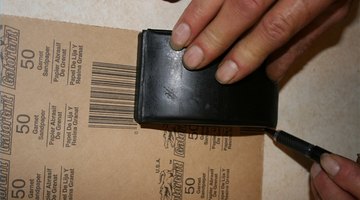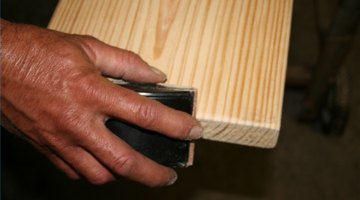How to Load and Use A Sanding Block
Sanding blocks are small and inexpensive, but are a big time-saver when you're working on small wooden furniture or craft projects. They are very easy to load and use once you get the hang of it. Sanding blocks can be purchased at your local building-supply or hardware store for under $10.

Things You Will Need
- Sanding block
- Sandpaper (9" x 11" sheets)
- Scissors
Tip
Sometimes it doesn't feel as if you have enough hands to load the sanding block, especially if this is your first attempt. You will find your own knack for doing it, and then it will be simple!
Warning
Always wear a mask and eye protection when sanding. Sand in a well-ventilated area to avoid exposure to excess dust.
-
Cut a strip from the sandpaper sheet to fit into the block. This strip should be 9" long, so be sure to position your sandpaper correctly, or you will be wasting some of it.
-
Place the sanding block on the edge of the sandpaper. Its length should be running parallel with the 9" length of the sandpaper, to optimize sandpaper usage. Draw a line to mark the width you need and cut your sandpaper strip. Slip the end of the sandpaper into the opening on one end of the block. The sandpaper should be facing up.
-
Wrap the sandpaper strip around the bottom of the sanding block, making sure the strip is smooth and tight. Set the block on the table. Pull up the top portion of the opening on the other side of the block and insert the sandpaper strip. Press the top back down firmly to secure the sandpaper.
-
Hold the sander in your hand, resting the curved top in your palm, much as you rest your hand on a keyboard mouse. To sand, gently push the sanding block back and forth on the surface you are sanding. The sanding block is quite easy to control to sand small corners and edges, and will quickly smooth out large surfaces.
-
Once you get the hang of loading and unloading the sanding block, your sanding chores will take a lot less time, and you will be saving wear and tear on your fingers and hands. Big electric sanders are nice for large jobs, but they can be too big and powerful for simple little jobs. Try using an inexpensive little sanding block, and you'll wonder how you ever got along without it.


The Drip Cap
- Sanding blocks are small and inexpensive, but are a big time-saver when you're working on small wooden furniture or craft projects.
- Cut a strip from the sandpaper sheet to fit into the block.
- Its length should be running parallel with the 9" length of the sandpaper, to optimize sandpaper usage.
- Wrap the sandpaper strip around the bottom of the sanding block, making sure the strip is smooth and tight.
- Once you get the hang of loading and unloading the sanding block, your sanding chores will take a lot less time, and you will be saving wear and tear on your fingers and hands.
Writer Bio
Donna Thacker has been a writer/photographer for over 15 years. She held the position of associate editor/writer/photographer at Biker Ally Magazine. She currently is a photojournalist for The Biking Life, and has been featured on the front page of The Greenville Advocate, The Hillsboro Journal and The Sorento News. Thacker also designed and published several booklets of historical interest for local organizations.
More Articles



